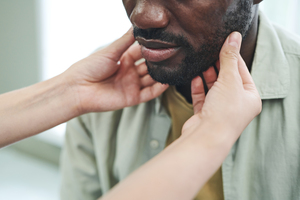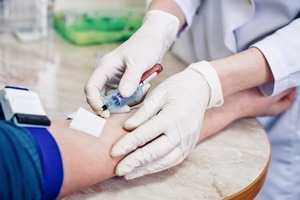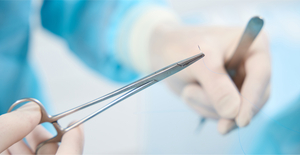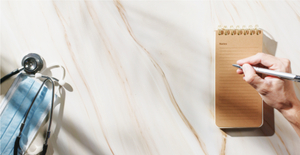Dyshidrotic Eczema Treatment
Dyshidrotic Eczema — also known as Dyshidrosis and Dyshidrotic dermatitis — is a chronic, relatively common skin condition that causes tiny blisters, or vesicles, on the palms of the hands, the soles of the feet, and between the fingers and toes, according to Cedars-Sinai Medical Center. Dyshidrosis may appear on one hand or foot, all hands and feet, or any combination between.
The vesicles, or blisters, caused by dyshidrotic outbreaks typically last 2 to 4 weeks, according to Cedars-Sinai. Outbreaks may return intermittently, although it is possible to experience a single flare-up of the condition, notes Cedars-Sinai. They add that the blisters are painful and itchy, and the itchiness may show up before the vesicles appear.
Dyshidrotic eczema should be diagnosed by a dermatologist or a nurse practitioner in dermatology.
What causes dyshidrotic eczema?
Although there is no known cause for dyshidrotic eczema, it is commonly exacerbated by stress, frequent handwashing, and very hot or cold temperatures. Working in a profession, such as hairstyling, that keeps your hands wet or damp for most of the day, will also exacerbate dyshidrotic eczema, notes Cedars-Sinai.
Who is at risk for developing dyshidrotic eczema?
According to Cedars-Sinai, some things may increase your chances of developing dyshidrosis, such as:
- Receiving UV radiation
- A history of atopic dermatitis
- Allergies
- Frequent exposure to irritants or allergens — metals, particularly nickel, are frequently liked to dyshidrosis
- Overactive sweat glands or having your hands frequently hands wet or moist
- Smoking
Dyshidrotic eczema in children
Dyshidrotic eczema is most prevalent among patients aged 20 to 40 reports Cedars-Sinai. They add, although eczema on the feet or hands is common in children, it’s usually atopic dermatitis, and rarely dyshidrosis.
Symptoms of dyshidrotic eczema
Dyshidrotic eczema appears on the hands and feet, and most people experience it only on their hands, notes the American Academy of Dermatology. Theylists the following symptoms:
- A frequent prickly, burning, itching sensation
- Tiny, fluid-filled vesicles or blisters on the palms of the hands, sides of fingers, and the soles of the feet and slides of toes.
- A prickling or itching that signals where blisters will appear in advance
- Pain from the blisters
- Blisters may appear in groups that develop into larger blisters
- Blisters may be wet with sweat
- Itchy bumps on fingers and hands
- Dry, scaly skin
- As blistered skin heals, it starts to peel, and skin will feel dry
- Dark spots may develop in place of blisters
Some individuals with dyshidrotic eczema find the condition impacts their quality of life, reports the Academy. This type of eczema on the feet can make shoes quite painful. Many people are unable to wear shoes or walk until their blisters clear, notes the Academy.
Flare-ups on the hands are also quite limiting, often causing patients to miss work because it’s too painful to perform ordinary tasks like typing or carrying boxes, reports the Academy.
How is dyshidrotic eczema diagnosed?
When diagnosing dyshidrotic eczema, a dermatologist will examine your skin and ask questions about your symptoms, lifestyle, and medical history. Sometimes they’ll perform a bacterial culture to rule out any secondary infections.
The dermatologist may also recommend allergy testing to identify specific allergens that could be exacerbating your eczema.
How is dyshidrotic eczema treated?
According to the National Eczema Association, Identifying potential eczema triggers is a part of both diagnosing and treating dyshidrosis. The more you can avoid dyshidrotic eczema triggers, the better off you’ll be. There are also prescriptions to improve your symptoms and help prevent flare-ups.
Treatments for mild outbreaks
The National Eczema Association notes that most people with dyshidrotic eczema will quickly improve by using topical corticosteroids and applying cool compresses or soaking blistered areas a few times daily. As dyshidrosis is often linked to fungal infections, dermatologists may also prescribe antifungals.
Conscientious self-care is also critical in dyshidrotic eczema treatment. The National Eczema Association recommends the following:
- Wash the affected feet and hands with a mild skin cleanser and pat dry gently.
- Apply a heavy moisturizing cream with ingredients to repair the damaged skin barrier. Your dermatologist can recommend products you can buy at the drugstore.
- Immediately after encountering an eczema trigger or allergen, wash and moisturize your hands and/or feet.
- Whenever you wash your hands, remove rings and bracelets to prevent water from getting trapped and lingering on your skin.
- Maintain short fingernails to minimize the damage done by scratching.
- Use stress management techniques to avoid stress bumps on your fingers and feet.
- If you are dealing with any kind of mental health issues, find treatment. These issues can manifest as physical symptoms.
Treatments for more severe outbreaks
If you are experiencing severe or frequent outbreaks of dyshidrotic eczema, or your treatment regimen isn’t working, your dermatologist may prescribe oral steroids, topical calcineurin inhibitors (TCIs), or light therapy. If you have hyperhidrosis (excessive sweating) in your hands and feet, you may be prescribed Botox injections to inhibit the overactive sweat glands.
Your doctor may also wish to investigate the possibility of some sort of systemic condition that could be contributing.
Home remedies for dyshidrotic eczema
Although there aren’t as many home remedies recommended for dyshidrosis as there are for other forms of eczema, several medical authorities like the Mayo Clinic recommend using cool, wet, compresses and oral antihistamines to relieve itching, and soaking the affected skin in witch hazel to accelerate healing.
You might find some of the commonly recommended eczema home remedies, such as bathing in colloidal oatmeal, to be helpful. However, dyshidrosis is not the same as atopic dermatitis, and you should consider each remedy an experiment you should try out one at a time, notes the National Eczema Association.
Diet changes
Although there is little evidence to back up the many “anti-eczema” diets touted across the internet, anyone with hypersensitivity to nickel or cobalt can reduce the frequency and severity of their dyshidrotic flare-ups by reducing these metals in their diet.
One of the easiest ways to keep track of the amount of nickel or cobalt you consume is to follow a point-based diet. Foods and beverages containing higher amounts of either metal are assigned a higher points value. Your dermatologist will give you information listing points values for foods and a recommended limit when you stop eating or drinking anything containing nickel or cobalt.
The point system is recommended over attempting to eliminate nickel and cobalt, as most beverages and foods contain at least a little bit of one or the other. Trying to avoid everything could cause a nutritional imbalance, not to mention a lot of frustration.
Complications of Dyshidrotic Eczema
The frequent scratching and broken blisters accompanying dyshidrotic eczema can easily lead to skin infections, notes the Mayo Clinic. They note that signs of infection include redness, swelling, and yellow crust around blisters. If you notice any of these signs, seek out urgent medical care. You could have a risky skin infection called cellulitis.
Prevention and Control of Outbreaks
The American Academy of Dermatology recommends a skin protection routine like the following to avoid the kind of irritation that leads to dyshidrotic eczema outbreaks.
- Always remove your rings before going to sleep, wash your hands, and apply moisturizer. Rings and the moisture they trap can irritate the skin, causing those itchy bumps on your fingers.
- Gently wash your hands with lukewarm water and a mild, fragrance-free cleanser. Avoid antibacterial or deodorant soaps, which are irritating.
- Apply moisturizer immediately after washing, when your skin is still damp. Re-apply moisturizer whenever your skin feels dry.
- If you use hand sanitizer, ask your dermatologist for a recommendation.
- Do whatever you can to avoid scratching. It causes irritation and worsens outbreaks. Also, bacteria live everywhere, and scratching can break the skin and cause infection.
- Protect your hands with gloves. Be sure to put gloves on BEFORE getting your hands wet or doing anything irritating. Also, choose the right gloves. Get thick, tough gloves for yard work, and waterproof gloves to keep your hands dry while washing dishes.
- Wearing 100% cotton gloves underneath other gloves will keep stiff seams and harsher materials like rubber or leather from irritating your sensitive skin.
- If you have dyshidrotic eczema on your feet, wear moisture-wicking socks to keep them dry.
Dyshidrotic Eczema in the Long-Term
There are some long-term changes that individuals with chronic, recurring Dyshidrosis may experience according to the American Academy of Dermatology:
- Thick, dry skin that constantly itches
- Regular skin inflammation
- Skin between fingers and toes that is spongy and soft.
- Scaly skin with deep, painful cracks
- Thick, discolored nails with pits and ridges
Find Dyshidrotic Eczema Treatment near you
- Alabama
- Alaska
- Arizona
- Arkansas
- California
- Colorado
- Connecticut
- Delaware
- Florida
- Georgia
- Hawaii
- Idaho
- Illinois
- Indiana
- Iowa
- Kansas
- Kentucky
- Louisiana
- Maine
- Maryland
- Massachusetts
- Michigan
- Minnesota
- Mississippi
- Missouri
- Montana
- Nebraska
- Nevada
- New Hampshire
- New Jersey
- New Mexico
- New York
- North Carolina
- North Dakota
- Ohio
- Oklahoma
- Oregon
- Pennsylvania
- Rhode Island
- South Carolina
- South Dakota
- Tennessee
- Texas
- Utah
- Vermont
- Virginia
- Washington
- Washington DC
- West Virginia
- Wisconsin
- Wyoming
Dyshidrotic Eczema Treatment FAQs
What is dyshidrotic eczema?
According to the American Academy of Dermatology, dyshidrotic eczema or dyshidrosis is a chronic skin condition that causes small blisters on the palms, soles, and between the fingers and toes. The blisters are most common on the hands and are usually itchy and painful. The itchiness often shows up before the blisters appear.
What causes dyshidrotic eczema?
According to the American Academy of Dermatology, the cause of dyshidrotic eczema is unknown, but it is made worse by stress, hot and cold temperatures, frequent handwashing, and keeping the skin frequently wet. People with overactive sweat glands, a history of atopic dermatitis or allergies, or who smoke are more likely to develop dyshidrosis.
How to treat dyshidrotic eczema
According to the American Academy of Dermatology, early dyshidrotic eczema treatment is usually a combination of self-care and prescribed medication. A dyshidrosis-friendly skincare routine uses gentle cleansers and keeps skin well-moisturized. Your dermatologist will likely prescribe you a topical corticosteroid, and possibly an antifungal. If you show signs of infection, you’ll likely need to take antibiotics, if recommended by a physician. To minimize outbreaks, it may be helpful to avoid skin irritation, and learn stress management techniques.
How to get rid of blisters on fingers
If you have blisters on your fingers from dyshidrosis, don’t try to pop them, notes the American Academy of Dermatology:You could introduce germs into your skin and develop a serious skin infection called cellulitis. Instead, see a dermatologist to have a dyshidrotic eczema treatment plan prescribed to you. This is the best way to heal the blisters without complications or scarring.
What are these clear itchy bumps on my hands?
According to the American Academy of Dermatology, if you have clear, itchy bumps on your fingers and hands, you may have dyshidrotic eczema, but should consult with a physician for diagnosis and treatment. The bumps are blisters, and there are treatments to clear them up, but you need to be diagnosed by a doctor who specializes in dermatology.
How common is dyshidrotic eczema?
Dyshidrotic eczema is seen in 5% to 20% of individuals with hand eczema reports the American Academy of Dermatology.
How long does dyshidrotic eczema last?
The itchy, painful vesicles or blisters of dyshidrotic eczema usually last between 2 and 4 weeks, reports the American Academy of Dermatology:. As the blisters heal, the skin dries and peels.
What’s the difference between eczema and dyshidrotic eczema?
While atopic dermatitis, or eczema, can be itchy and painful like dyshidrotic eczema, it does not present with the blisters seen in dyshidrosis and can appear on many parts of the body other than the hands and feet.
Where can I get dyshidrotic eczema treated?
Dyshidrotic eczema should always be treated by a dermatologist, a doctor who specializes in the medical treatment of the skin.
Solv can help you find same-day, expert, dermatology care for dyshidrotic eczema treatment, Allow us to help you find fast, convenient, medical care near you.
Solv has strict sourcing guidelines and relies on peer-reviewed studies, academic research institutions, and medical associations. We avoid using tertiary references.
Everyday Healthcare, Simplified
Expert advice to help you live your best life








